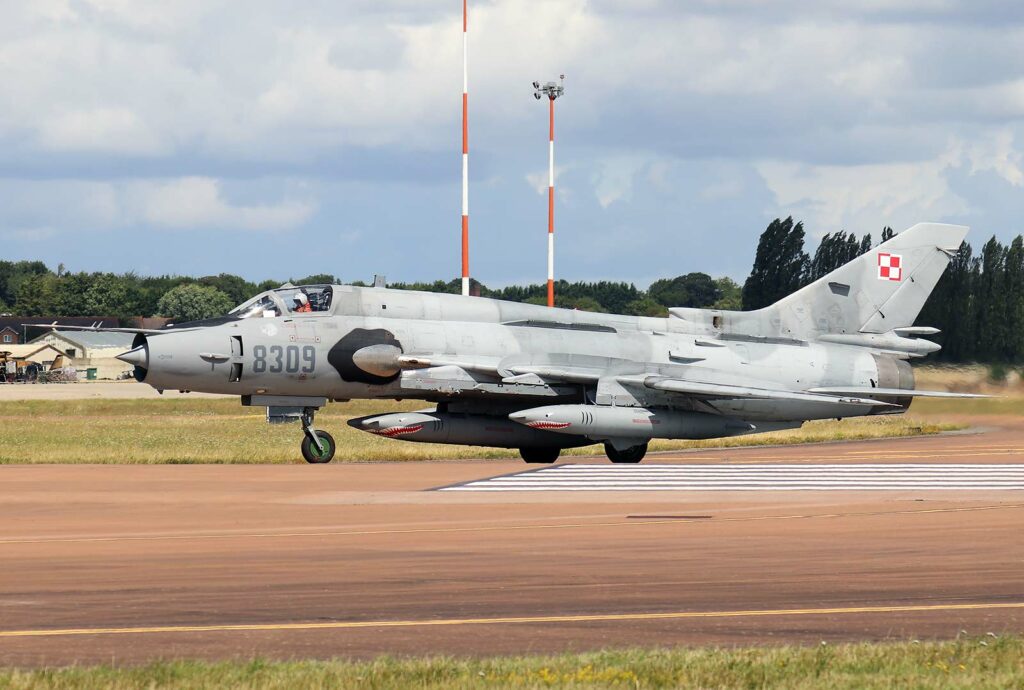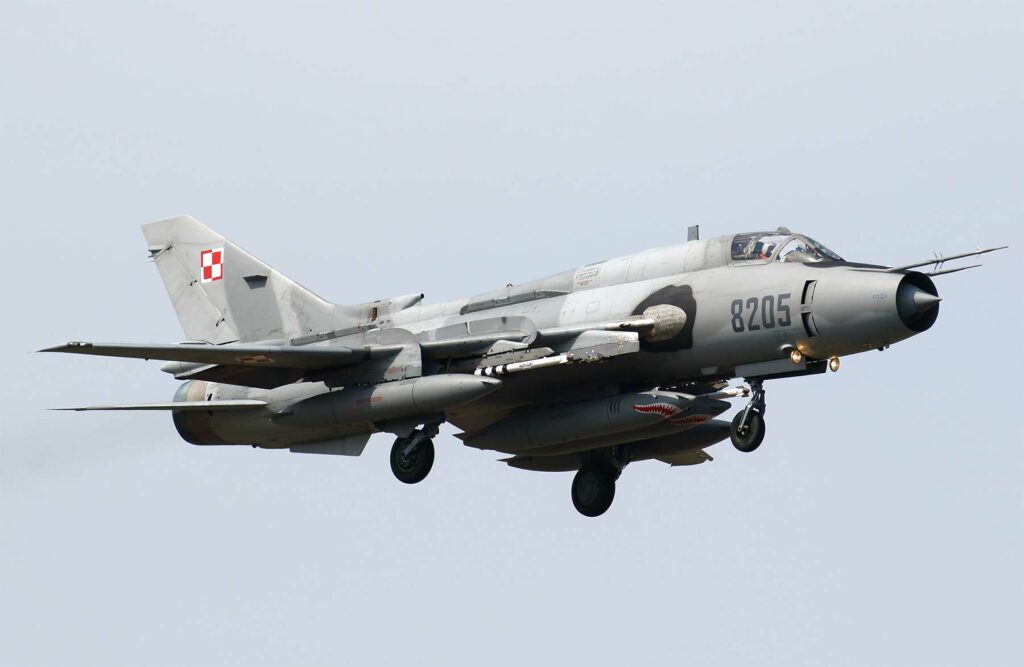The Sukhoi Su-17 “Fitter” is a Soviet variable-sweep wing fighter-bomber, evolving from the Su-7 with enhanced avionics and operational capabilities.
In brief
The Su-17 “Fitter” emerged as a significant advancement over its predecessor, the Su-7, by incorporating variable-sweep wing technology. This innovation allowed the aircraft to excel in a variety of roles, from close-air support to nuclear strike missions. With a production span from 1967 to 1990, it saw extensive service across numerous air forces worldwide. Its versatility was further demonstrated through its ability to carry an array of weaponry, including nuclear arms. The Fitter series includes the Su-17, Su-20, and Su-22, each variant introducing improvements in avionics, weaponry, and performance.

History of the Development of the Sukhoi Su-17
The Sukhoi Su-17 development was initiated to address the limitations of the Su-7, particularly its takeoff/landing performance and lack of flexibility in operational roles. By integrating variable-geometry wings, a concept that was gaining attention in the 1960s, the Sukhoi Design Bureau, led by Nikolay Zyrin, created a platform that could adapt its aerodynamic profile for optimal performance across different flight regimes. This adaptability was proven in the prototype’s first flight in 1966 and subsequent entry into production in 1969. The Su-17 marked a significant technological leap, not just for Soviet aviation but for the global understanding of variable-sweep wing benefits in military aircraft.
Design of the Sukhoi Su-17
The Su-17’s design is characterized by its variable-sweep wings, which allowed for a wide range of flight profiles. This flexibility was critical for improving the aircraft’s takeoff and landing performance, range, and overall maneuverability. The aircraft utilized hydraulic systems to adjust wing sweep angles and flight control surfaces, ensuring optimal performance. It was powered by a Lyulka AL-7F1-250 turbojet engine, providing significant thrust and enabling the use of RATO boosters for short runway operations. The design also included provisions for carrying nuclear weapons, with special systems for safe arming and delivery.
Performance of the Sukhoi Su-17:
The Su-17 series showcased impressive performance metrics, with the ability to reach speeds exceeding Mach 1. It featured a high service ceiling and a combat range that could be extended with auxiliary fuel tanks. Its performance was continually enhanced across its variants through improvements in engine output and avionics, including the introduction of laser rangefinders and advanced navigation systems in later models like the Su-17M2 and Su-17M4. These enhancements ensured the Fitter remained a formidable aircraft throughout its service life.
Variants of the Sukhoi Su-17
The Su-17’s lineage includes several notable variants, each designed to fulfill specific operational needs. The initial Su-17 models were followed by the export-oriented Su-20 and Su-22, with the latter becoming particularly widespread internationally. Subvariants introduced significant upgrades such as improved engines, enhanced avionics, and modifications to improve pilot visibility and aircraft range. The series evolved to include advanced trainers, reconnaissance models, and versions specialized in electronic warfare, showcasing the platform’s versatility.

Military Use and Combat of the Sukhoi Su-17
Throughout its service, the Su-17 was employed in various military operations across the globe. Its combat roles ranged from direct ground support to engaging in air-to-surface missions, demonstrating its effectiveness in diverse operational contexts. The aircraft participated in numerous conflicts, where its ability to carry a wide range of munitions, including precision-guided weapons, was highly valued. Despite facing competition from contemporary Western and Soviet designs, the Su-17 proved to be a resilient and adaptable platform. It was exported to several countries, seeing action in the Middle East, Africa, and beyond. Although it has been phased out by many operators, its impact on tactical aviation and the development of variable-sweep wing technology remains significant.
The Sukhoi Su-17 “Fitter” series represents a pivotal chapter in military aviation history. Its development and operational use highlighted the advantages of variable-sweep wing technology in enhancing aircraft performance across a broad spectrum of missions. From its inception in the Cold War era to its widespread adoption across various air forces, the Su-17 demonstrated the Soviet Union’s innovative approach to tactical aircraft design. Its legacy, carried on through numerous variants and extensive service records, underscores the enduring value of flexibility and adaptability in military aviation.
Back to the Fighter Jet section.